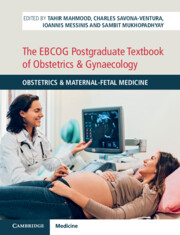Book contents
- The EBCOG Postgraduate Textbook of Obstetrics & Gynaecology
- The EBCOG Postgraduate Textbook of Obstetrics & Gynaecology
- Copyright page
- Dedication
- Contents
- Contributors
- Preface
- Section 1 Basic Sciences in Obstetrics
- Section 2 Early Pregnancy Problems
- Section 3 Fetal Medicine
- Section 4 Maternal Medicine
- Section 5 Intrapartum Care
- Chapter 43 Normal Labour
- Chapter 44 Issues during Labour for Migrant Populations
- Chapter 45 Prolonged Pregnancy
- Chapter 46 Induction of Labour
- Chapter 47 Intrapartum Fetal Monitoring
- Chapter 48 Augmentation of Labour
- Chapter 49 Analgesia and Anaesthesia during Labour
- Chapter 50 Preterm Labour
- Chapter 51 Management of Multiple Pregnancy during Labour
- Chapter 52 Abnormal Obstetric Presentation
- Chapter 53 Intrapartum Emergencies
- Chapter 54 Caesarean Section
- Chapter 55 Instrumental Operative Obstetrics
- Chapter 56 Maternal Collapse in Labour
- Chapter 57 Management of Postpartum Haemorrhage
- Chapter 58 Birth Injuries and Perineal Trauma
- Chapter 59 Management of Stillbirth
- Section 6 Neonatal Problems
- Section 7 Placenta
- Section 8 Public Health Issues in Obstetrics
- Section 9 Co-Morbidities during Pregnancy
- Index
- Plate Section (PDF Only)
- References
Chapter 45 - Prolonged Pregnancy
from Section 5 - Intrapartum Care
Published online by Cambridge University Press: 20 November 2021
- The EBCOG Postgraduate Textbook of Obstetrics & Gynaecology
- The EBCOG Postgraduate Textbook of Obstetrics & Gynaecology
- Copyright page
- Dedication
- Contents
- Contributors
- Preface
- Section 1 Basic Sciences in Obstetrics
- Section 2 Early Pregnancy Problems
- Section 3 Fetal Medicine
- Section 4 Maternal Medicine
- Section 5 Intrapartum Care
- Chapter 43 Normal Labour
- Chapter 44 Issues during Labour for Migrant Populations
- Chapter 45 Prolonged Pregnancy
- Chapter 46 Induction of Labour
- Chapter 47 Intrapartum Fetal Monitoring
- Chapter 48 Augmentation of Labour
- Chapter 49 Analgesia and Anaesthesia during Labour
- Chapter 50 Preterm Labour
- Chapter 51 Management of Multiple Pregnancy during Labour
- Chapter 52 Abnormal Obstetric Presentation
- Chapter 53 Intrapartum Emergencies
- Chapter 54 Caesarean Section
- Chapter 55 Instrumental Operative Obstetrics
- Chapter 56 Maternal Collapse in Labour
- Chapter 57 Management of Postpartum Haemorrhage
- Chapter 58 Birth Injuries and Perineal Trauma
- Chapter 59 Management of Stillbirth
- Section 6 Neonatal Problems
- Section 7 Placenta
- Section 8 Public Health Issues in Obstetrics
- Section 9 Co-Morbidities during Pregnancy
- Index
- Plate Section (PDF Only)
- References
Summary
Prolongation of pregnancy was described for the first time in the nineteenth century as case reports. The fact that a fetus remaining longer than what is considered normal in the uterine environment can have harmful effects on the fetus was first reported in 1911 by Adam Wright, who recommended ‘induction of labour’ as a routine procedure within two or three days after due date [1].
- Type
- Chapter
- Information
- The EBCOG Postgraduate Textbook of Obstetrics & GynaecologyObstetrics & Maternal-Fetal Medicine, pp. 373 - 380Publisher: Cambridge University PressPrint publication year: 2021

